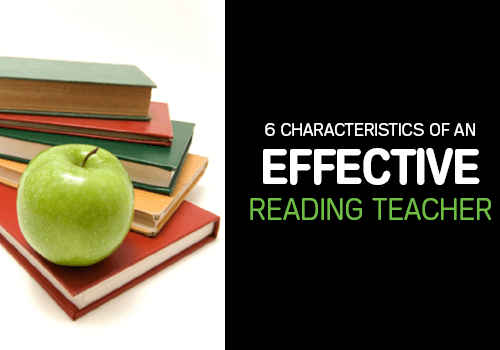It seems like there has been a lot of talk lately about measuring ‘teacher effectiveness’. In fact, some organizations are spending a lot of time and money trying to identify effective teachers and compare them to their less-than-effective peers in an attempt to define what a good teacher does to get desired results. Ironically, we as teachers are, understandably, so caught up in the immediacy of teaching that we forget to reflect on what good teaching looks like to us. After spending several years as a literacy coach observing classrooms and helping teachers use data to drive instruction, I have noticed some similarities among teachers who get good results. (I am speaking quantitatively and qualitatively, by the way.) For what it is worth, these are just a few of my observations about what makes a good teacher.
What makes an effective reading teacher?
1. Good teachers believe in their students.
This means that they have high expectations for each one of their students. I remember meeting with a first-grade teacher who had a student born with Fetal Alcohol Syndrome. While observing whole-class explicit phonics instruction, I noticed Tom (not his real name) playing with blocks at the back of the room while the rest of the class was participating in the lesson. When I asked about Tom, the teacher replied, “Tom is playing with blocks because that is all Tom will ever be capable of.” Needless to say, Tom did not learn to read anything in first grade. However, during his second-grade year, Tom had a teacher who had high expectations for Tom. He made more than one year of progress in reading that year and, as his second-grade teacher expected, was capable of much more than playing with blocks.
2. Good teachers are introspective about their teaching.
While in college, I worked as an aide in a second-grade classroom. Daily, I observed Mrs. O take notes on each lesson that she taught so she could improve her teaching. I watched her change her instruction multiple times based on evaluation and re-evaluation of how her students responded to her Structured Literacy instruction. Over the years, I have continued to see even the toughest students make significant progress in her class. As a literacy coach, it was not uncommon to be approached by well-meaning teachers asking if I would observe a lesson and then give them feedback, any feedback, on how they could improve their teaching. Of course, that was a good practice, and good things sometimes came of that process. What was less common, however, was being asked to observe a very specific element of teaching that had been identified by a teacher who had already engaged in a very reflective analysis of their own teaching. In every case, introspective teachers became even more effective than they already were.
3. Good teachers are constantly monitoring students’ responses to their instruction.
This means espousing the belief that assessment is part of teaching in all of its forms (formative, summative, formal, and informal). As a result, these teachers do not teach to the test; they often teach beyond the test. These teachers are the same teachers who can readily recognize good practices when they see them because of student response patterns. They are not the kind to “throw the baby out with the bathwater” with the adoption of a new basal program. They can effectively identify what works for students and what does not.
4. Good teachers develop good relationships with students and parents.
When instructing pre-service teachers, I tell them that the greatest secret to classroom management is getting to know each of their students individually. At the beginning of each school year, I took turns having lunch with each of my students. I soon realized that the time spent one-on-one getting to know each student proved to be invaluable as it related to knowing how to differentiate instruction for each of my first graders. I also saw that the mutual respect that resulted greatly influenced student motivation. Part of getting to know each student involves building relationships with their families. Good teachers include parents as an important part of the classroom culture, building a greater sense of community. As they say, it takes a village.
5. Good teachers are good learners.
The teachers who I respect most are the teachers who keep things fresh by constantly learning new things about what they are teaching. These teachers are willing to read books, take classes, organize study groups, and learn new and innovative technologies. They are also open to learning new things even if they go against the way they were taught or practices accepted based on tradition rather than evidence. Conversely, I have seen a whole grade level of teachers who went to great lengths to preserve an assessment that was so old that it was out of print just because they would rather keep doing what they have always done rather than use something new and more informative. I know teachers are strapped for time, but I think the key to continued learning is at least being willing to learn new things.
6. Good teachers have a life outside of the classroom.
A balance between work and personal life can also contribute to effective and enthusiastic teaching. Teachers who have a hard time maintaining this balance either become the kind of person who lives, eats, and breathes, teaching, which is the fast track to burn out, or they become the kind of teacher that arrives and leaves with the students, which is the fast track to lack of student progress. A good teacher is also a happy, well-balanced person.
I am sure that there are many other factors that I didn’t list or haven’t recognized yet. I hope that if you have taken the time to read this post, you will also take the time to think about what being a good teacher means to you (before good teaching is defined for all of us in the name of accountability).

